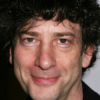Neil Gaiman

Neil Gaiman
Neil Richard MacKinnon Gaiman is an English author of short fiction, novels, comic books, graphic novels, audio theatre, and films. His notable works include the comic book series The Sandman and novels Stardust, American Gods, Coraline, and The Graveyard Book. He has won numerous awards, including the Hugo, Nebula, and Bram Stoker awards, as well as the Newbery and Carnegie medals. He is the first author to win both the Newbery and the Carnegie medals for the same work, The...
NationalityBritish
ProfessionNovelist
Date of Birth10 November 1960
CityPortchester, England
Sometimes I think that ideas float through the atmosphere like huge squishy pumpkins, waiting for heads to drop on.
When I was about ten my favourite article in the huge and mouldering Encyclopedia Britannica we owned (the ninth edition) was the one on Lycanthropy. (Yes, I had a favourite 1890s Britannica article when I was ten. I am now aware this is not entirely usual.)
[I spent] much of my time reminding Matt Groening that I really need to be a head in a jar on Futurama.
As for thinking time versus writing time, well, that's up to you. But - and I wish it were otherwise - books don't get written by thinking about them, they get written by writing them. And that's when you make discoveries about what you're writing. That's when you get the happy accidents.
Dinner with Steven Moffat in Bar Shu, spent mostly in enthusiastic Dr Who neepery. I love my life....As a side note, running Windows Vista on the Panasonic w7 is making me really nostalgic for 1986. Whoever thought I'd get to type things then stare at a blank screen for a bit and one-by-one watch the letters appear? Cory and Mike's 'Why Don't You Run Linux?' talks are staring to seem much more sensible.
I have world class photographic red-eye pretty much all the time. As a general rule, if it's taken with a flash, I look like I am possessed by the blazing forces of darkness, at least in the eye department.
I'm more or less happily writing Chapter Six of The Graveyard Book. I say more or less as I'm at that place where I hope that the book knows what it's doing because right now I don't have a clue - I'm writing one scene after another like a man walking through a valley in thick fog, just able to see the path a little way ahead, but with no idea where it's actually going to lead him.
Classic authors should be older than I am, and wiser, and on-top of all their deadlines.
Style is made up of whatever an author can't avoid doing.
Children, as I have said, use back ways and hidden paths, while adults take roads and official paths.
The really important thing to be was yourself, just as hard as you could.
There's a tale in the Caballa that suggests that the Angel of Death is so beautiful that upon seeing it (or him, or her) you fall in love so hard, so fast, that your soul is pulled out through your eyes. I like that story.
This is how you can tell a real photographer: mostly, a real photographer does not say 'I wish I had my camera on me right now'. Instead a real photographer pulls out her camera and takes the photograph.
"Only write what you know" is very good advice. I do my best to stick to it. I wrote about gods and dreams and America because I knew about them. And I wrote about what it's like to wander into Faerie because I knew about that. I wrote about living underneath London because I knew about that too. And I put people into the stories because I knew them: the ones with pumpkins for heads, and the serial killers with eyes for teeth, and the little chocolate people filled with raspberry cream and the rest of them.